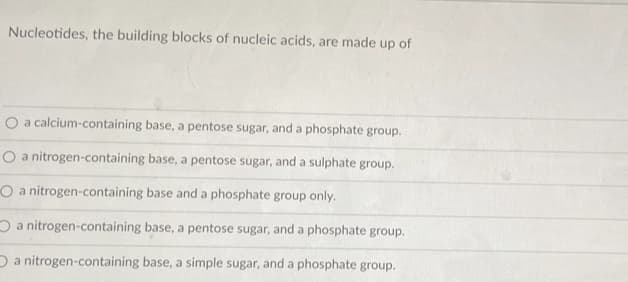Nucleotides, the building blocks of nucleic acids, are made up of a calcium-containing base, a pentose sugar, and a phosphate group. O a nitrogen-containing base, a pentose sugar, and a sulphate group. O a nitrogen-containing base and a phosphate group only. Da nitrogen-containing base, a pentose sugar, and a phosphate group. Da nitrogen-containing base, a simple sugar, and a phosphate group.
Nucleotides, the building blocks of nucleic acids, are made up of a calcium-containing base, a pentose sugar, and a phosphate group. O a nitrogen-containing base, a pentose sugar, and a sulphate group. O a nitrogen-containing base and a phosphate group only. Da nitrogen-containing base, a pentose sugar, and a phosphate group. Da nitrogen-containing base, a simple sugar, and a phosphate group.
Biology 2e
2nd Edition
ISBN:9781947172517
Author:Matthew Douglas, Jung Choi, Mary Ann Clark
Publisher:Matthew Douglas, Jung Choi, Mary Ann Clark
Chapter6: Metabolism
Section: Chapter Questions
Problem 1VCQ: Figure 6.8 Look at each of the processes shown, and decide if it is endergonic or exergonic. In each...
Related questions
Question

Transcribed Image Text:Nucleotides, the building blocks of nucleic acids, are made up of
O a calcium-containing base, a pentose sugar, and a phosphate group.
O a nitrogen-containing base, a pentose sugar, and a sulphate group.
O a nitrogen-containing base and a phosphate group only.
O a nitrogen-containing base, a pentose sugar, and a phosphate group.
Da nitrogen-containing base, a simple sugar, and a phosphate group.
![For the reaction B A at standard conditions with [B] =1 M and [A] =1 M, AG is initially a large negative
number. As the reaction proceeds, [B] decreases and [A] increases until the system reaches equilibrium.
How do the values of AG and AG" change as the reaction moves toward equilibrium?
both AG and AG stay the same
O AG reaches zero and AG" becomes more negative
AG becomes less negative and AG" stays the same
AG stays the same and AG becomes less negative
AG becomes positive and AG" becomes positive](/v2/_next/image?url=https%3A%2F%2Fcontent.bartleby.com%2Fqna-images%2Fquestion%2F5e5efc23-a198-4327-bdc7-d2931bd5f43b%2Fb798846b-1705-41ee-a1e1-5c2d186ebb1a%2Fcvotonm_processed.jpeg&w=3840&q=75)
Transcribed Image Text:For the reaction B A at standard conditions with [B] =1 M and [A] =1 M, AG is initially a large negative
number. As the reaction proceeds, [B] decreases and [A] increases until the system reaches equilibrium.
How do the values of AG and AG" change as the reaction moves toward equilibrium?
both AG and AG stay the same
O AG reaches zero and AG" becomes more negative
AG becomes less negative and AG" stays the same
AG stays the same and AG becomes less negative
AG becomes positive and AG" becomes positive
Expert Solution
This question has been solved!
Explore an expertly crafted, step-by-step solution for a thorough understanding of key concepts.
This is a popular solution!
Trending now
This is a popular solution!
Step by step
Solved in 4 steps

Knowledge Booster
Learn more about
Need a deep-dive on the concept behind this application? Look no further. Learn more about this topic, biochemistry and related others by exploring similar questions and additional content below.Recommended textbooks for you

Biology 2e
Biology
ISBN:
9781947172517
Author:
Matthew Douglas, Jung Choi, Mary Ann Clark
Publisher:
OpenStax

Biology 2e
Biology
ISBN:
9781947172517
Author:
Matthew Douglas, Jung Choi, Mary Ann Clark
Publisher:
OpenStax